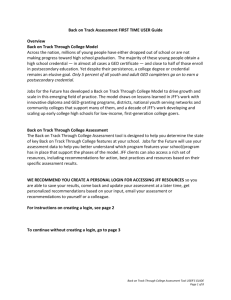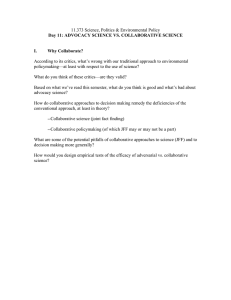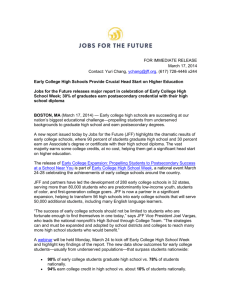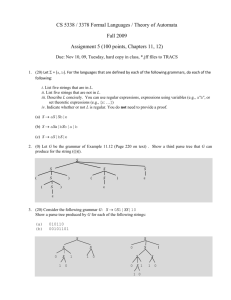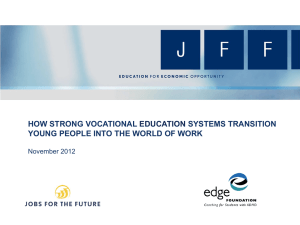N S -B O
advertisement
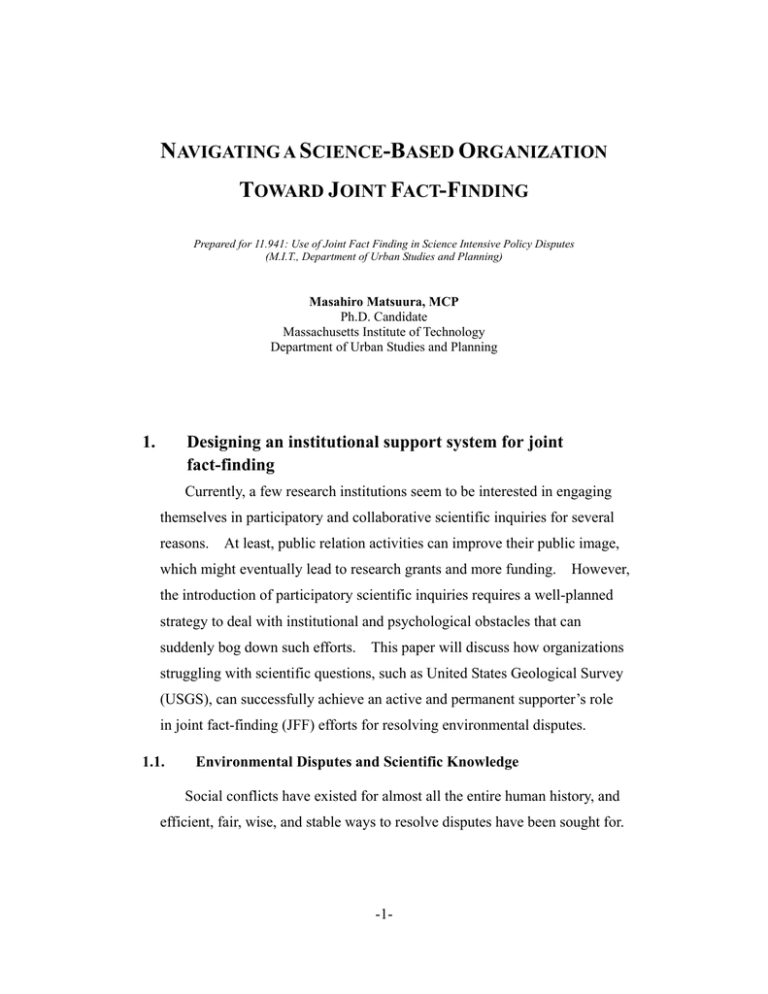
NAVIGATING A SCIENCE-BASED ORGANIZATION TOWARD JOINT FACT-FINDING Prepared for 11.941: Use of Joint Fact Finding in Science Intensive Policy Disputes (M.I.T., Department of Urban Studies and Planning) Masahiro Matsuura, MCP Ph.D. Candidate Massachusetts Institute of Technology Department of Urban Studies and Planning 1. Designing an institutional support system for joint fact-finding Currently, a few research institutions seem to be interested in engaging themselves in participatory and collaborative scientific inquiries for several reasons. At least, public relation activities can improve their public image, which might eventually lead to research grants and more funding. However, the introduction of participatory scientific inquiries requires a well-planned strategy to deal with institutional and psychological obstacles that can suddenly bog down such efforts. This paper will discuss how organizations struggling with scientific questions, such as United States Geological Survey (USGS), can successfully achieve an active and permanent supporter’s role in joint fact-finding (JFF) efforts for resolving environmental disputes. 1.1. Environmental Disputes and Scientific Knowledge Social conflicts have existed for almost all the entire human history, and efficient, fair, wise, and stable ways to resolve disputes have been sought for. -1- 11.941:Final Paper (2003 Fall) Masahiro Matsuura For example, mediation was practiced even in the biblical times1. The ideas of resolving dispute between the members of the public are nothing new. In modern times, public disputes are more and more concerned with the natural environment and our living conditions. Policy-makers and social scientists investigated systems that could resolve such environmental disputes. In 1973, a regional dispute over the construction of Snoqualmie River Dam in Washington was successfully resolved through mediation. Mediation techniques that had been used in the field of labor negotiation were applied to this Snoqualmie case, and it is generally agreed that this was the first case of environmental mediation2. Since then, mediation has been used in the efforts across the country to resolve environmental disputes. Environmental disputes have become more complex as the field of applied environmental science advanced. Members of the public are more and more cautious about the implications of changing the status quo. Discoveries of negative impacts from chemical substances on human bodies, as well as on fauna and flora, have raised the level of public concerns about potential suffering from industrial developments. For example, Susskind and Cruikshank document a dispute over the implications of human health effects of dioxin3. In the dioxin case, perceptions of the tiniest potential risk triggered an intense environmental dispute even though the risk of suffering cancer from the dioxin emission was not clearly understood. Innovations in social science added another spectrum to the complexity of environmental disputes. Most notably, the methods to valuate environmental goods, such as contingency valuation (CVM) and travel cost 1 Moore, C. W. (1996). The Mediation Process: Practical strategies for resolving conflict. San Francisco: Jossey-Bass, p. 20. 2 Dukes, E. F. (1996). Resolving Public Conflict: Transforming community and governance. Manchester: Manchester Univ., pp. 28-32. 3 Susskind, L. and Cruikshank, J. (1987). Breaking the Impasse. New York, NY: Basic Books, pp. 66-70. -2- 11.941:Final Paper (2003 Fall) Masahiro Matsuura ) method (TCM), opened a new battlefield for disputants with skills of policy analysis. These methods were used to attach monetary values to intangible goods such as landscape and ecosystems. Cost-benefit analyses, combined with these valuation methods, were conducted as a qualification for public spending. However, the validity and the objectivity of environmental valuation have been repeatedly questioned in controversial situations. Slightly different assumptions could yield completely different valuations of an identical object. What count toward the “environment” has also been a subject of questions: the items to be added as cost or benefit could be chosen subjectively in order to manipulate the cost/benefit (c/b) ratio. Cost-benefit analysis, which was supposed to facilitate more rational decision-making, is being utilized as a tool to justify predetermined decisions. 1.2. Adversarial Science and JFF Unfortunately, additional scientific knowledge has been the source of, rather than the solution for, environmental disputes. In many confrontational disputes in which stakeholders are dichotomized into factions, each side presents different data sets and “scientific” analyses that support its positions—it is adversarial science. Adversarial science is strategically and selectively deployed as an instrument for the advancement of one’s own subjective interests, although it is presented as an objective measure to evaluate alternative plans and their potential outcomes. Disputes become complex as the focus of the conflict moves away from each party’s interests to the construal of scientific information. To deal with the adversary nature of science-intensive disputes, the theory of joint fact-finding (JFF) was developed on the practice of environmental mediation. Joint fact-finding is a process in which “stakeholders with differing viewpoints and interests work together to develop data and information, analyze facts and forecasts, develop common assumptions and informed opinion, and, finally, use the information they -3- 11.941:Final Paper (2003 Fall) Masahiro Matsuura have developed to reach decision together4” In most joint fact-finding efforts, scientific advisors are invited so that the stakeholders, often without adequate scientific knowledge, can take advantage of the best available scientific information. Rather than being an advocate for a specific party of a dispute, scientists join as an neutral information source for the deliberation of all stakeholders. Therefore, the stakeholders should agree on the selection of their scientific advisors at the outset in order to prevent adversarial science surfacing in the following discussions. If adversarial science had been a significant source of a deadlock in a dispute, the contending scientists can be invited to the joint fact-finding effort so that their differences in assumptions and methodologies can be clarified to the stakeholders. 1.3. Institutionalized JFF System and Helper’s Role In the environmental dispute resolution efforts, there are many areas in which scientific questions can play a significant role in helping the stakeholders reach a successful agreement. Therefore, someone might suggest integrating JFF into the environmental mediation process as a default option. However, formalization of environmental mediation is likely to undercut its advantages. Unlike lawsuits, each mediation effort should be designed flexibly for each instance so that it can address the conflict at hand most effectively. The question of whether or not to use JFF, and how to use it, should still be left to the hands of stakeholders and process designers who are responsible for resolving their own disputes. Creating an institution that support individual JFF efforts might be a more sensible alternative. Most stakeholders in environmental disputes are likely to find JFF necessary, although they need to maintain their authority 4 Ehrmann, J.R. and Stinson, B.L. (1999). Joint Fact-Finding and the Use of Technical Experts, In Susskind, L., McKearnan, S., and Thomas-Larmer, J. (Eds.) The Consensus Building Handbook: A Comprehensive Guide to Reaching Agreement. Thousand Oaks: Sage. -4- 11.941:Final Paper (2003 Fall) Masahiro Matsuura and responsibility over the design of their own mediation effort. If there were a “helper” institution, the stakeholders would find it easier to set up their own JFF process by taking advantage of the services offered by the institution. Without such an institution, stakeholder group in each dispute has to use their own resources to identify the most appropriate assistance they need for their JFF. Here, institutions refer not only to organizations with formally recognized members but also to rules formally or informally observed by relevant actors5. For example, grants programs, published manuals, and educational programs can also be considered as such institutions in that they also provide support for the stakeholders. These institutions can assist the potential users of JFF by providing fund, information, and expertise respectively. Science-based organizations can take the helper’s role by making their scientific expertise always available for JFF efforts. What are the merits of creating institutions to help JFF? institutions can benefit from the economy of scale. First, the As the number of JFF cases multiplies, essential resources for JFF can be shared by an institution as a resource pool. will be reduced. The cost of obtaining and maintaining the resources Second, institutions can create and provide a new meeting point where potential users and providers of JFF-related services are matched. For example, annual conferences on JFF can physically bring together both users and suppliers of relevant resources. Having a meeting point will make it easier for the potential users to find the most appropriate supplier of scientific knowledge. In addition, the meeting point can serve as a marketplace that can lower the cost of obtaining scientific information through competitions among suppliers. Then, how can we create such helper institutions? 5 It is likely that the North, Douglass C. (1990). Institutions, Institutional Change and Economic Performance. New York, NY: Cambridge University -5- 11.941:Final Paper (2003 Fall) Masahiro Matsuura strategies of creating an institution depends on the type of the institution one is envisioning. If we look at scientific expertise for JFF efforts and the balance between its supply and demand, it seems that the supply of assistance from scientific experts is not meeting the current demands from stakeholders needing assistance for their joint inquiries. In the US, as much as 3.4 million individuals were employed as scientists and engineers in 19976. However, no science-based organization has ever expressed its intent to become a helper institution for JFF efforts. For instance, USGS has just launched an initiative to introduce the idea of JFF to its scientists, but the organization hasn’t made any commitment to provide more proactive assistances to JFF7. At the same time, there are several organizations that provide the management services for JFF efforts from a neutral standpoint, such as the Consensus Building Institute (CBI) in Massachusetts and Concur in California. If a few of the existing science-based organizations in the US proactively provide assistances to JFF efforts, the supply-side of the market is likely to saturate quickly. However, it hasn’t occurred. There seem to be strong resistances to such an organizational change. What factors are drawing the organizations and scientists back from taking an active helper’s role in JFF? In the next section, I will discuss possible explanations for why few scientists so far have engaged themselves in JFF efforts. 6 National Science Board, Science & Engineering Indicators – 2000. Arlington, VA: National Science Foundation, 2000 (NSB-00-1) p.3-7 7 Clayton, T. “Joint Fact Finding: A New Approach to Balancing Science and Politics in Ecosystem- and Resource-Management Decisions” Sound Waves (Dec. 2002/Jan. 2003) [http://soundwaves.usgs.gov/2003/01/meetings3.html] -6- 11.941:Final Paper (2003 Fall) Masahiro Matsuura 2. Obstacles to Taking a Helper’s Role in JFF Efforts 2.1. 2.1.1. Institutional Obstacles Organizational Lock-in One of the reasons for organizations of not changing their role can be traced to organizational lock-in. Once the way of doing businesses is institutionalized within an organization, the members of the organization often reject the idea of changing it even if better ways are available because the act of changing would require additional resources on individual members. Even if it is evident that a change will benefit the organization as a whole in the long run, it is often better for the employees not to change in a short term in order to minimize the burden each member has to take. For example, when a manufacturing firm tries to introduce a new machine to improve its productivity, its employees will not like it if they have to take many courses on how to operate the machine. The concept of lock-in is originally emerged in the field of technological innovation: the inefficacy of QWERTY keyboards, compared to other configuration such as the Dvorak keyboard, has been recognized for long but no one has ever succeeded in replacing them8. The cost of purchasing and getting used to a new configuration of keyboard exceed their benefits for individual users. In the context of becoming a JFF helper organization, it might be advantageous for a science-based organization to take an active role in JFF as a long-term strategy. However, for the individual scientists employed by the organization, that kind of change will require additional burdens on them in the short run. For instance, the scientists will have to discuss their specialization with laypeople in plain language during the JFF efforts. 8 This David, P. (1985). “Clio and the Economics of QWERTY,” American Economic Review. 75 (2), p332-337 -7- 11.941:Final Paper (2003 Fall) Masahiro Matsuura will require a new set of communication skills that had never been expected for the scientists. Thus, for some scientists who are not confident of their communication skills, the introduction of JFF ideas into their organization is perceived as a risk to their job security. Other factors that contribute to the lock-in effect include the scientists’ work schedule. They might refuse to participate in the JFF meetings, saying, “I don’t want to participate in public meetings late in the evening or on weekends. I have commitments to my family!” The resistance for a change can be stemming from the perceptions held by the scientists. Uncertainties associated with an organizational change might make it appear more costly than it actually is, especially if they have not seen it successful in other organizations. Even if an organization could achieve an internal agreement on its proactive participation in JFF efforts, similar organizations might try to impede the effort because they do not like to see a trigger for a change in the scientific community as a whole. 2.1.2. The Strength of Reductionism The number of scientific disciplines has increased rapidly in modern times. Pioneers of the science have explored the new fields and found additional research agenda for further investigation. The expansion of the field of science is partly facilitated by what is known as “reductionism.” It assumes that the mankind can understand the systems of the universe by dissecting scientific inquiries into smaller pieces. Following this line, scientists have been able to achieve advancements in the field of science by focusing on particular sub-domains of the scientific disciplines in which they were engaged. This inevitably limits individual scientist’s attention to a very narrow range of issues that their colleagues haven’t investigated because the frontier of science lies in these sub-domains. However, if we cast a suspicious eye, the idea of reductionism has an economical rationality in expanding the field of “science” by encouraging -8- 11.941:Final Paper (2003 Fall) Masahiro Matsuura the junior scientists to create new sub-fields that others haven’t looked into. The process of dividing the scientific disciplines into pieces is similar to that of mitosis. Division of a cell (i.e. scientific discipline) will create new cells that can host new nucleus (i.e. scientist), and eventually the organism as a whole (i.e. the field of science) will enlarge. It is rational for junior scientists to create a new discipline because it will give them a niche market: the scientist who could successfully differentiate from others will benefit from being the sole source of information relevant to that new field. The more disintegrated the scientific disciplines are, the more specialized and powerful individual scientists will be. This system reduces the usefulness of individual scientists in JFF efforts. In JFF, a broad range of questions will be raised by the laypeople. They are concerned about specific locations or impacts, but their frame of reference is not constructed in the way scientific disciplines are organized. It is likely that the answers to their question require various knowledge from several disciplines of science. Thus, reductionist scientists will not be able to answer those broadly structured questions. generalist scientists. Instead, JFF efforts want Scientific advisors are expected to have a broad coverage of scientific knowledge. As each scientist strives for scientific discoveries by limiting his or her focus, it makes it more difficult for them to provide adequate information in JFF settings. Scientists themselves might hesitate to participate in a JFF discussion that requires a broad range of scientific knowledge. They might think they are not qualified, or they worry that the participation will jeopardize their credibility by not being able to answer the general questions posed by laypeople. -9- 11.941:Final Paper (2003 Fall) Masahiro Matsuura 2.2. 2.2.1. Psychological Barriers Lack of Trust and Reactive Devaluation It is likely that the JFF participants from local communities will make “subjective” arguments based on their observations. These “anecdotal” evidences are exactly what the scientists are trained to stay away from. Such arguments might make the scientists feel, “they are not trustworthy because they reason from such biased information.” If the scientists have participated in controversial public hearings on the promoter’s side to provide scientific evidence, they might have negative feelings toward the public in general because of the experience of having been verbally attacked. If the scientists do not trust the other participants with whom they will deliberate in the JFF efforts, the scientists will not believe in what they are talking about. If the scientists can’t listen to what the others say, they can’t serve the role of scientific advisor in a meaningful way because they can’t rightly address the questions from the laypeople. Scientists need to empathize with the stakeholders to some degree to fully understand the puzzles they are trying to solve. Even worse, a scientist might not be able to comprehend any suggestions from the other participants objectively only because of the negative feelings he or she has toward them. The negative feeling can devaluate the value of the comments just because of its attribution. This psychological phenomenon, known as “reactive devaluation,” can be a source of obstacle because the scientist can’t provide an objective evaluation of potentially innovative ideas9. If scientists anticipate these problems, they are not likely to endorse the idea of becoming a JFF helper organization. 9 Ross, L. (1995). “Reactive Devaluation in Negotiation and Conflict Resolution.” In Arrow, K., Mnookin, R., Ross, L., Tversky., A. & Wilson, R. (Eds.) Barriers to Conflict Resolution. New York, NY: W.W. Norton Co. pp. 26-42 -10- 11.941:Final Paper (2003 Fall) Masahiro Matsuura 2.2.2. Incompatible Representation and Conception: Boundary Objects In the meetings aimed for public dispute resolution, same objects and concepts are sometimes described in different ways by different participants. Slightly different presentations of ideas by a few participants often lead to intractable and never-ending discussions that frustrate other participants. This is not necessarily limited to the discussions among laypeople, but also applies to those among knowledgeable scientists. It is not a simple semantic problem that can be solved by preparing terms of references. The problem lies in how each individual’s mind operates. For example, language can limit and expand individual’s ability of conceiving ideas10. It is often said that Eskimos can conceive snow more in detail than English-speaking people can because their language has many more words than English does to represent “snow11.” The same thing can be applied to the “languages” used in different scientific disciplines: the way a scientist uses to represent his or her ideas (e.g. texts, equations, or diagrams) creates a cognitive boundary around him or her. For instance, Peter Galison articulates this point using the case of the Rad Lab at MIT12. The Lab brought together engineers and physicists in the 1940s in order to develop a device that can generate microwave radiation to be used in warfare. Initially, the Lab researchers had difficulties in working collaboratively. Eventually, the financial and organizational pressures made them invent what Galison calls boundary objects—the researchers modified their own theories so that they can funnel their theories into a practical project, as Galison says, “... the war forced theoretical physicists to spend day after day calculating things about devices and, 10 Hall, E. (1966). The Hidden Dimension. Garden City, NY: Doubleday. There’s a discussion among scholars of language whether it is a scientific truth or just a hoax. See, Pullum, G. (1991). “The Great Eskimo Vocabulary Hoax” In The Great Eskimo Vocabulary Hoax and Other Irreverent Essays on the Study of Language. Chicago: Univ. of Chicago Press 12 Galison, P. (1997). Image and Logic: A Material Culture and Microphysics. Chicago: Univ. of Chicago Press 11 -11- 11.941:Final Paper (2003 Fall) Masahiro Matsuura through these materials objects, linking their own prior language of field theory to the language and algebra of electrical engineering.13” The invention of coordinating language among the Rad Lab scientists under the gun was the key to the successful coordination. JFF efforts for resolving environmental disputes are likely to require interactions among scientists from different scientific disciplines because of the multiplicity of environmental impacts. Especially if scientists from different disciplines are contending on the scientific implications of a public policy proposal, the conversation between them needs to be carefully managed so that each scientist will understand what the other scientists are referring to. Interactions between the scientists and laypeople can also be difficult in that the laypeople have no understandings of the esoteric terms the scientists might use. On the one hand, the laypeople can spend some time at the outset studying a few basics of relevant science. On the other hand, the scientists should be encouraged to use terms that are most easily understood by all participants. 2.2.3. Interaction Rituals In Interaction Ritual, Erving Goffman suggests that human interactions are initiated with some sorts of rituals that are intended to save one’s own and others’ faces14. Such ritualistic interactions in public policy deliberations are articulated by John Forester, using a term transformative rituals15. These rituals are culturally determined because such rituals have to be mutually recognized by all parties involved. For instance, Japanese businesspeople ritually exchange their business cards before initiating their business talks. 13 14 15 Intentionally skipping this ritual is normally considered an Galison. ibid. p. 824 Goffman, E. (1967). Interaction Ritual: Essays on Face-to-face Behavior. Garden City: Anchor Books. Forester, J. (1999). The Deliberative Practitioner. Cambridge, MA: MIT -12- 11.941:Final Paper (2003 Fall) Masahiro Matsuura extremely rude act that jeopardizes the face of others16. In the same context, the scientists in the organization that want to take the helper’s role in JFF might entertain such ritualistic interactions without being explicitly recognized. I have not yet identified literature referring to any sort of transformative rituals for interactions among scientists. However, it is highly likely that each organization has its own tacit but ritualistic rules. For example, showing up in a meeting room before the scheduled time is considered extremely important in some organizations, and not much in others. Making informal comments without receiving formal approvals by superiors is valued as “a positive attitude” in some organizations, while it is considered as “an overplay” in other organizations. If taking an active role in JFF efforts suggests the infringement of the basic rules of such rituals entertained by important members of the organization, the initiative to take the JFF helper’s role is likely to be obstructed by them. Although this obstacle might be relatively easy to overcome by designing a JFF process that is acceptable to those people, it is an element that should be explicitly considered in designing a JFF process. 2.2.4. Attachment to “Scientific” Theories The idea of JFF itself might be considered as a threat to the “credo” that the scientists, especially natural scientists, have embraced for centuries. Traditionally, scientific theory is considered valid when it passed rigorous testing of hypothesis. The underlying assumption behind the idea of hypothesis testing is the replicability of a theory: it should be universally and eternally applicable to the instances that the theory is dealing with. However in reality, practitioners in organizations are acting on tacit theories that are not clearly stated and validated through hypothesis testing. Schön 16 For example, a department head of a prefecture government crumpled a business card offered by the governor, as a sign of protest against his policy. Later he was harshly criticized for his “rude act,” and made a public apology for the rudeness. See [http://www.tbs.co.jp/news23/taji/s01030-e.html] -13- 11.941:Final Paper (2003 Fall) Masahiro Matsuura and Argyris referred to such practical theories as theories-in-use17. Meanwhile, many scientists might not acknowledge the validity of such theories-in-use because they don’t meet rigorous standards for theoretical validity. In most JFF efforts, it is likely that the stakeholders in environmental disputes are seeking for practical solutions that can ultimately resolve their conflict. The solution does not have to be universally applicable; rather, they want the most effective theory-in-use even if it is not effective at different settings. For the rigorous scientists who are trained to quest for universally applicable theories, the discussion of theories-in-use might be felt like a waste of time because it does not contribute to “the good science.” This obstacle resides only in the minds of the scientists. They need to acknowledge the legitimacy of theories-in-use that the stakeholders really want before entering into a JFF effort. An organization can’t easily change the mind of its scientists because the issue almost touches on their identity. Because of this nature of their attachment to espoused theories, the organization might have to give up transforming some of its most adamant employees. 3. Three-step Model of Organizational Change 3.1. Steady moves in order to avoid traps Considering those obstacles, what are the possible measures to change a science-based organization into a proactive assistant for JFF efforts in scientific matters? Now it may be evident that these obstacles will surely trap a naïve initiative encouraging scientists to become a JFF helper. Instead, the change process is must be carefully in advance. In this article, I suggest a three-step model to transform a science-based 17 Argyris, C. and Schön, D. (1996). Organizational learning II. Reading: Addition-Wesley -14- 11.941:Final Paper (2003 Fall) Masahiro Matsuura organization into a proactive assistant to JFF efforts in scientific matters. The three steps are organizing, experimenting, and institutionalizing. The idea draws on the literatures that suggesting practical designs of dispute resolution systems in organizational settings18. Corporations are looking for an “alternative” dispute resolution system that can curtail the risk of expensive lawsuits. These literatures warn their readers about the possible failures arising from the lack of preparation against possible obstacles. They consistently suggest the importance of preparation. 3.2. 3.2.1. Three-step model Organizing phase The three-step model starts with organizing. In this step, relevant stakeholders get together to articulate a strategy for an organizational change. Anyone who conceives usefulness of introducing JFF into the organization becomes an entrepreneur for the change. As the idea circulates around the organization, a group of entrepreneurs develops after informal discussions either at the top, the bottom, or both levels of the organization. Groups of entrepreneurs are not a project team to manage a change effort; rather, they are just organizers that trigger an organizational movement. First, the entrepreneurs need to identify who are the stakeholders that should be involved in the effort. In order to move forward with the change as an organization, not as an ad-hoc group of high-spirited individuals, a sort of stakeholder analysis must be conducted from an objective standpoint. If 18 Ury, W., Brett, J., and Goldberg, S. (1988). Getting Disputes Resolved: Designing Systems to Cut the Costs of Conflict. San Francisco, CA: Jossey-Bass; Constantino, C and Merchant, C. (1996). Designing Conflict Management Systems: A Guide to Creating Productive and Healthy Organizations. San Francisco, CA: Jossey-Bass.; Slaikeu, K. and Hasson, R. (1998). Controlling the Costs of Conflict: How to Design a System for Your Organization. San Francisco, CA: Jossey-Bass. -15- 11.941:Final Paper (2003 Fall) Masahiro Matsuura some important stakeholders were not involved in the design process, the implementation of changes would be at risk. For example, top executives who were not involved in a change process that originates from the junior staff might implement a totally different plan out of blue with a top-down approach. If top executives do not involve the field staffs in planning, the effectiveness of the change plan is likely to be low because it does not reflect the realities in the field. Scientists and staff in the field can easily sabotage the top-down directives. Involvement of all relevant parties is only the way to avoid such inefficiency. Thus, the change effort is similar to a consensus building process because anyone who has a stake in the implementation of a plan should be involved from the outset. Then, they need to agree that there is a need for an organizational change. If there is no need for it, why an organization should change? stake their jobs just for the sake of management fads. Staff won’t To make a change possible, ongoing problems associated with the organization’s performance in science-intensive discourse need to be identified. This is exactly the joint fact-finding of organizational situations with the participation of all stakeholders. They need to investigate and understand why their active involvement in JFF efforts is necessary. In the context of dispute resolution systems design, Constantino and Merchant warn the possibilities of system designers and advocates pushing too hard for a change even if the organization does not need one19. Entrepreneurs of a JFF introduction effort need to distance themselves from making too much commitment to their initial ideas. They should discover the needs again from the perspective of organization as a whole, together with relevant stakeholders. Assuming all relevant parties have agreed for a change, they need to 19 Constantino and Merchant. ibid. pp. 90-95 -16- 11.941:Final Paper (2003 Fall) Masahiro Matsuura identify possible obstacles to the change effort. As I mentioned in the previous section, there are many possible obstacles to introducing JFF to an organization. Scientists might not accept the idea of deliberating with laypeople. Management staff might not like taking new assignments in which they have no confidence. Each organization has its own potential obstacles, and the stakeholders have to identify them before taking actions. 3.2.2. Experimenting Phase Some obstacles, such as the lack of confidence in communicating with laypeople, can be rooted in fears and bad experiences. Scientists who have participated in public hearings held in a contentious atmosphere between proponents and opponents might feel a strong aversion from any discussion with the public just because of that traumatic experience. In order to overcome such obstacles, it is advantageous for every relevant party to experiment proactive participations in a few selected JFF efforts without committing to the whole change organizationally. For the top management, they do not have to commit a large investment to something they have never experienced. Executives can make a full-fledged decision changing an organization after observing the progress in the experiments. For the advocates of the change, they can identify failures in their initial plan. Also, they can demonstrate the effectiveness to those who object to their ideas. For those who fear a change, this will be a chance to overcome their anxiety. The experiment will serve as a learning opportunity for the scientists who need a new set of skills. 3.2.3. Institutionalizing phase Finally, an organizational change will be implemented by diverse measures, such as articulating new management rules, restructuring departments, and setting up new training courses for its employees. A plan needs to be articulated as a document, and the management should decide -17- 11.941:Final Paper (2003 Fall) Masahiro Matsuura whether or not to implement the plan. Because the management has been involved in the effort from the outset, it is likely that the plan will be implemented without much surprise. 4. Conclusion This article reviewed the prospects and pitfalls of an organizational change as an effort to create an institutional capacity of providing scientific knowledge for JFF efforts. Although several organizations currently provide support on the management of the JFF process, organizations with scientific expertise have not yet stepped into the field as a helper institution. I suggest existing organizations with a vast amount of scientific knowledge, such as the USGS, take that role. In order to assume the new role, organizations have to overcome institutional and psychological obstacles. This article reviewed some obstacles an organization might encounter during the organizational change. It also suggested a three-step model that tries to minimize the risk of having the initiative bogged down by some of the obstacles to an organizational change. The significance of scientific inquiries in public disputes is mounting year by year. Stakeholders of dispute resolution efforts will continue to depend on scientists’ projections about how the environment will change. The users of these projections will never stop requesting improvements in their accuracy. The scale of scientific issues that JFF has to deal with is also diversifying. At the largest scale, negotiation over the treaty on global warming requires the JFF on how the climate is likely to change in the long term. At the minimum scale, public policies on food safety might require a JFF on the implications of emerging issues, such as genetically engineered organisms (GMO), bovine spongiform encephalopathy (BSE), and the use of antibiotics in food products. Because of these increasing demands, it is likely that a few organizations dealing with scientific issues will seriously consider taking the helper’s role -18- 11.941:Final Paper (2003 Fall) Masahiro Matsuura in JFF. This article provides a segway into the effort for change; however, in order to substantiate the suggestions in this article, we need to wait for an empirical study of how players in an organization actually negotiate among themselves toward the transformation into an institution that permanently provides scientific expertise for JFF efforts. Bibliography Argyris, C. and Schon, D. (1996). Organizational learning II. Reading: Addition-Wesley. Clayton, T. "Joint Fact Finding: A New Approach to Balancing Science and Politics in Ecosystem- and Resource-Management Decisions" Sound Waves (Dec. 2002/Jan. 2003) [http://soundwaves.usgs.gov/2003/01/meetings3.html] Constantino, C and Merchant, C. (1996). Designing Conflict Management Systems: A Guide to Creating Productive and Healthy Organizations. San Francisco, CA: Jossey-Bass. David, P. (1985). "Clio and the Economics of QWERTY," American Economic Review. 75 (2), p332-337 Dukes, E. F. (1996). Resolving Public Conflict: Transforming community and governance. Manchester: Manchester Univ. Ehrmann, J.R. and Stinson, B.L. (1999). Joint Fact-Finding and the Use of Technical Experts, In Susskind, L., McKearnan, S., and Thomas-Larmer, J. (Eds.) The Consensus Building Handbook: A Comprehensive Guide to Reaching Agreement. Thousand Oaks: Sage. Forester, J. (1999). The Deliberative Practitioner. Cambridge, MA: MIT Press. Galison, P. (1997). Image and Logic: A Material Culture and Microphysics. Chicago: Univ. of Chicago Press. Goffman, E. (1967). Interaction Ritual: Essays on Face-to-face Behavior. Garden City: Anchor Books. Hall, E. (1966). The Hidden Dimension. Garden City, NY: Doubleday. Moore, C. W. (1996). The Mediation Process: Practical strategies for resolving conflict. San Francisco: Jossey-Bass National Science Board, Science & Engineering Indicators - 2000. Arlington, VA: National Science Foundation, 2000 (NSB-00-1) p.3-7 North, Douglass C. (1990). Institutions, Institutional Change and Economic Performance. New York, NY: Cambridge University Pullum, G. (1991). "The Great Eskimo Vocabulary Hoax" In The Great Eskimo Vocabulary Hoax and Other Irreverent Essays on the Study of Language. Chicago: Univ. of Chicago Press. Ross, L. (1995). "Reactive Devaluation in Negotiation and Conflict Resolution." In Arrow, K., Mnookin, R., Ross, L., Tversky., A. & Wilson, R. (Eds.) Barriers to Conflict Resolution. New York, NY: W.W. Norton Co. pp. 26-42 Slaikeu, K. and Hasson, R. (1998). Controlling the Costs of Conflict: How to Design a System for Your Organization. San Francisco, CA: Jossey-Bass. -19- 11.941:Final Paper (2003 Fall) Masahiro Matsuura Susskind, Lawrence and Cruikshank, Jeffrey (1987). Breaking the Impasse. New York, NY: Basic Books Ury, W., Brett, J., and Goldberg, S. (1988). Getting Disputes Resolved: Designing Systems to Cut the Costs of Conflict. San Francisco, CA: Jossey-Bass -20-
